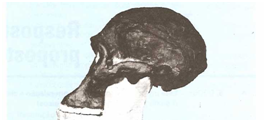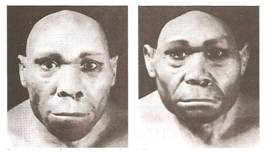The Origin of Man
The chronology of the origin of man and his evolution is not accurate. There are numerous classifications, often contradictory, as there are still several important gaps.
In general, we can say that a common coregave rise to the great apes or anthropoids (Pongidae) and humans (Hominidae).
At some point, these two families formed and evolved in different directions: the Pongidae took the gorilla forms, chimpanzee, orangutan and gibbon current while Hominidae gone through several transformations, until Homo sapiens sapiens.
Australopithecus
Hominids and hominids are classified into two kinds. The first is the Australopithecus (Latin australis = southern + Greek pithecos = monkey), which had physical characteristics still far from modern man. The second is the genus Homo, to which we belong. It is unknown whether Homo evolved from Australopithecus or if both are independent genres, connected to a common ancestor. But everything indicates that early hominids lived in Africa South-East.
There are three known species of Australopithecus. Australopithecus aferensis is the oldest, having lived about 3 million years ago. But the Australopithecus africanus and Australopithecus robustus existed respectively to 1.5 and 1 million years before our era, and the A. africanus may have given rise to the genus Homo. These three species are clearly differentiated from Pongidae because, despite its small cranial ca4acidade (400 cm3 for A. aferensis and 500 cm for others), had bipedal posture and did not have large tusks (canine teeth) existing in anthropoids.
Homo habilis
There are about 2 million years - so being a later species the origin of man, contemporary of Australopithecus africanus and robustus Australopithecus - came the first species of the genus Homo: Homo habilis, so named for its ability to use, for the first time , sharp stones or sharp to break wrappers seeds , dig the earth in search of roots or butchering animals. His cranial volume ranged between 650 and 800 cm3. Besides, it had a less curved posture than the australopithecines.
Homo erectus
About 1.5 million years ago, Homo habilis, hitherto restricted to Africa, gave rise to a species that would spread to Asia and Europe: Homo erectus. This, in addition to demonstrating a remarkable evolution in the use of stone tools (knives, axes, scrapers), must have started the spoken language and, for about 500,000 years, begun to take shelter in caves and produce fire. In the physical aspect, Homo erectus did not exceed 1.5 m in height; It had raised eyebrow arch and a massive jaw, devoid of chin. The head articulates with the spine so as to be slightly projected forward.
Besides the many fossils of Homo erectus found in Africa, they were discovered other, slightly different, Asia and Europe. They are the Javantropo the Sinantropo and Paleantropo (Greek anthropos = man), located respectively in Java (Indonesia), near Beijing (China) and Heidelberg (Germany). The three were classified as subspecies of Homo erectus and received, complementing the javanensis denominations pekinensis and heidelbergensis.
Approximately 300,000 BC, Piorno erectus began to undergo changes that would result in the species to which we belong: Homo sapiens.
Neanderthal Man
subspecies oldest remains of Homo sapiens were first discovered in the valley (in German = thal) Rio Neander, Germany; hence they received the scientific name of Homo sapiens neanderthalensis. Similar examples would later be found in France, Yugoslavia, Palestine and North Africa.
The height of the Neanderthal man was little more than 1, 5 m. His skull had to slightly flattened in the occipital, with very sloping forehead back, robust jaws and sharp little chin. The eyebrow arch was less prominent than in previous species.
Neanderthals hunted in groups and sheltered from the cold in caves. They lived between 120,000 and 35,000 BC The reasons for its disappearance are unclear, but many must to have interbred or been cut off for the second and more evolved subspecies of Piorno sapieM called scientifically Homo sapiens sapiens - that is, the current man.
Homo sapiens
Homo sapiens sapiens appeared around 40,000 BC The first specimens studied were discovered in a village South of France; then they are appointed by the name of man of Cro-Magnon. It was higher than the Neanderthals and were under heavy facial features, with elongated skull, a broad forehead and rounded chin.
Homo sapiens sapiens replaced the Neanderthal and around 25000 BC, spread throughout the Earth. It was up to him toperfect the techniques of obtaining food, expanding the forms of social organization, structure, religion and producing artistic events. And over time, Homo sapiens sapiens originated the human races .
Currently, many scholars avoid using the term race to designate a human group with a particular phenotype; instead, they prefer the word ethnicity. The reason for this rejection is mainly ideological, due to the negative connotation of "race" with "racism" (anti-scientific attitude based on the alleged superiority of certain races over others).
As the concept of ethnicity also involves cultural peculiarities, it is difficult not to use the word race when taking into account the strictly physical characteristics of human groups (color of the skin and eyes, height, skull shape and face types nose and hair etc.). Bad, these characteristics are studied by Physical Anthropology, while the Cultural Anthropology conducting ethnographic and ethnological studies.
It is believed that the current races have resulted from the attachment of certain groups in specific areas, which medium is adapted. In this case, as procreation was processed within a limited universe, accentuated if certain physical traits, distinguishing one group from another. It is obvious that such differences do not imply any idea of superiority or inferiority of these groups.
Please Share
Category: General history















0 komentar